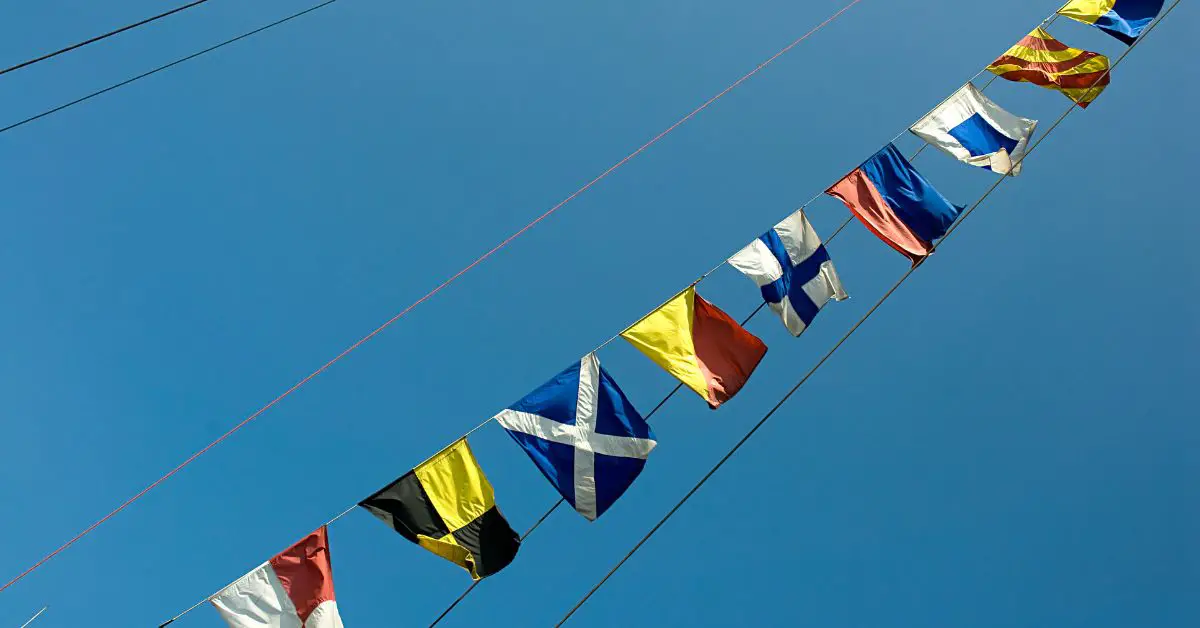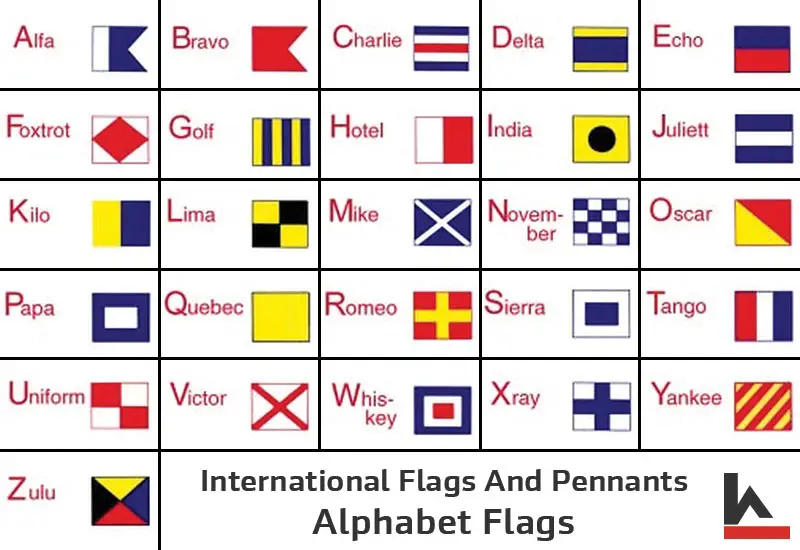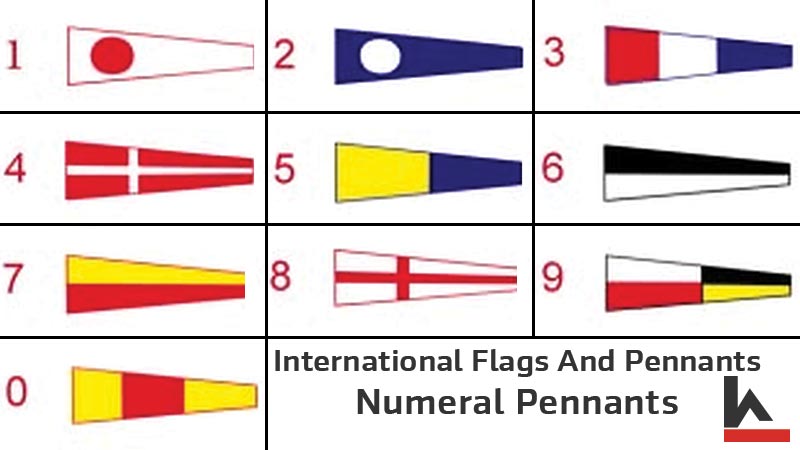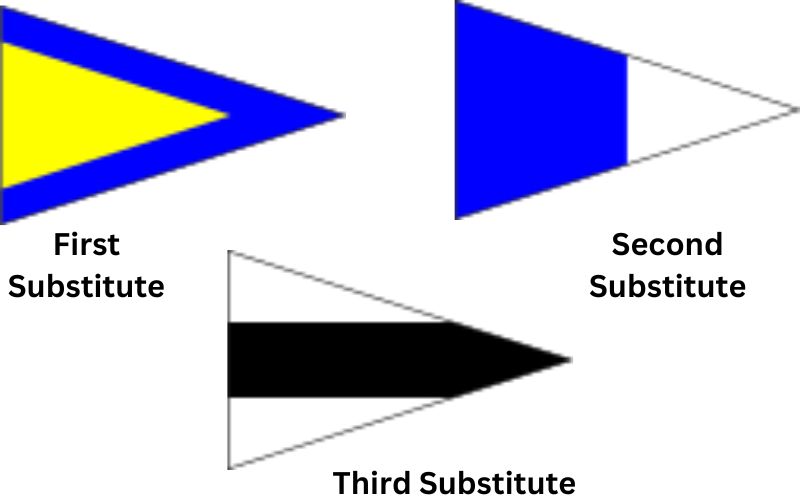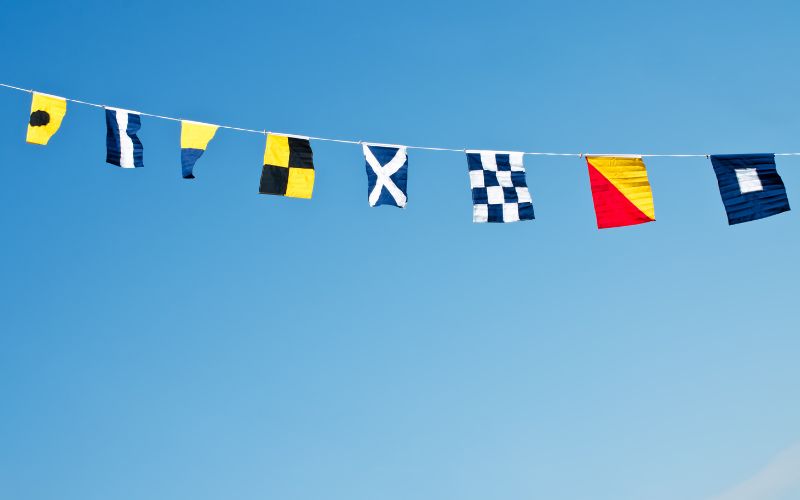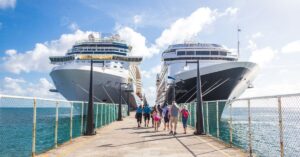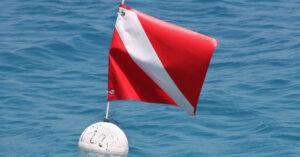Originating from the 19th century, nautical flags are a vital communication tool amongst mariners worldwide. Boasting a rich blend of colors and patterns, these maritime signal flags still resonate today, transmitting critical information between vessels, marking hazardous cargo, and keeping the essence of our maritime heritage alive.
Each flag in this system, often square but occasionally pennant-shaped, signifies a distinct letter, number, or message, forming a robust communication network on the open seas. The configuration consists of 26 alphabetic flags, ten numeral pennants, three substitutes, and one answering pennant, all designed to be visible, even from a distance, thanks to their high-contrast color schemes.
Whether you are a seasoned sailor or a maritime enthusiast, understanding the meanings of these flags can lend an extra layer of appreciation and depth to your navigational experiences. Immerse yourself in the world of nautical flags and explore their rich history and practical uses.
Types and Meaning of Nautical Flags
Nautical flags serve as communication tools in maritime settings, each type having a unique purpose. From numeral pennants and alphabet flags to substitute flags and geographical signals, the range of international code signal flags facilitates efficient communication between vessels.
These flags foster smooth sailing and prompt communication among mariners, whether indicating dangerous cargo, signaling for assistance, or requesting a course change. Let’s explore nautical flags and learn more about the meanings behind their vibrant symbols.
1. Alphabet or Letter Flags: Symbols and their Significance
Known as the nautical flag alphabet or international maritime signal flags, alphabet flags are a set of 26 square flags that serve as a visual communication method when direct verbal exchange is impractical.
Each flag corresponds to a letter of the alphabet, thus, enabling vessels to communicate messages or spell words visually. The flags are designed with striking colors and contrasting patterns to enhance visibility. Combined or singly, these flags can convey various messages and information between vessels.
They play a pivotal role in maritime communication as part of the International Code of Signals, guaranteeing effective and standardized communication between sea-faring vessels. Here is what each alphabet flag represents:
- A – Alpha: Diver down; keep clear
- B – Bravo: Dangerous cargo on board
- C – Charlie: Yes (affirmative)
- D – Delta: Keep clear; I am maneuvering with difficulty
- E – Echo: Altering my course to starboard
- F – Foxtrot: I am disabled; communicate with me
- G – Golf: I require a pilot
- H – Hotel: Pilot on board
- I – India: I am altering my course to port
- J – Juliet: I am on fire; keep clear of me
- K – Kilo: I wish to communicate with you
- L – Lima: You should stop your vessel immediately
- M – Mike: My vessel is stopped, making no way through the water
- N – November: No (negative)
- O – Oscar: Man overboard
- P – Papa: All personnel return to ship; It is dangerous to overtake me
- Q – Quebec: My vessel is healthy, and I request free pratique
- R – Romeo: The way is off my ship; you may feel your way past me
- S – Sierra: I am operating astern propulsion
- T – Tango: Do not pass ahead of me
- U – Uniform: You are running into danger
- V – Victor: I require assistance
- W – Whiskey: I require medical assistance
- X – X-ray: Stop carrying out your intentions and watch for my signals
- Y – Yankee: I am dragging anchor
- Z – Zulu: I require a tug
2. Numeral Pennants: Numbers at Sea
Numeral pennants are vital in conveying numerical information between vessels. These flags convey numerical information between ships, allowing for effective communication without needing verbal or written messages.
There are ten numeral pennants, each representing a specific number from zero through nine. To communicate a number greater than nine, multiple flags can be combined to represent the intended number. Here is a guide to these numeral flags and their numerical equivalents:
- Numeral pennant zero: Represents the number zero
- Numeral pennant one: Represents the number one
- Numeral pennant two: Represents the number two
- Numeral pennant three: Represents the number three
- Numeral pennant four: Represents the number four
- Numeral pennant five: Represents the number five
- Numeral pennant six: Represents the number six
- Numeral pennant seven: Represents the number seven
- Numeral pennant eight: Represents the number eight
- Numeral pennant nine: Represents the number nine
Using these numeral flags greatly enhances the quick and efficient transmission of numerical data between ships, ensuring smooth navigation.
3. Substitute Flags: Streamlining Communication
Also referred to as repeater flags, substitute flags are used to navigate situations where a letter appears multiple times in a communication message. These three flags, part of the International Code of Signals, streamline the entire process of communication.
When a letter repeats in a signal, the corresponding substitute flag is used in its place. For example, if a signal includes “B” multiple times, the substitute flag for “B” is used for its subsequent appearances. Here’s what each substitute flag is intended for:
- 1st Substitute: Used as substitutes for of “A”
- 2nd Substitute: Used as substitutes for “B”
- 3rd Substitute: Used as substitutes for any letter other than of “A” or “B”.
Substitute flags are also used to signal certain phrases like “I am altering my course to port” by flying the substitute flag for the letter “I” followed by the flag representing the letter “P”.
It is important to note that substitute flags do not have any specific meaning and are only used to replace letters that have already been signaled. They are an important component of the nautical flag and are used to streamline and simplify the process of maritime communication.
Related Article: Boat Flags, Nautical Flags and Marine Flags: Types and Meanings
4. Decoding Flags: Solo or Combined
Nautical flags, flown solo or in combination, convey diverse meanings. Each flag encapsulates a specific message, fostering effective communication at sea.
A single flag might indicate a vital message. For instance, the Alpha “A” flag signals a diver’s presence underwater, warning nearby vessels to steer clear. In contrast, the Whiskey “W” flag alerts others of a medical emergency onboard.
Signals of two flags often hint at distress or maneuvering issues. For example, a combination of the Hotel (H) and Sierra (S) flags shows that a vessel cannot maneuver due to an external factor, prompting nearby vessels to keep their distance and lend assistance if possible.
When communication demands compass points, geographical signals, or positional details, mariners use a combination of three or more flags. These advanced signals transmit precise information to foster operational efficiency.
The Role and Importance of Nautical Flags
Nautical flags serve as a crucial tool for universal communication among mariners, transcending linguistic barriers to convey messages and information efficiently. Here are some roles of nautical flags:
1. Communication Between Ships and Boats
These flags allow sailors to rapidly communicate with other nearby seafaring vessels, thus providing timely alerts about potential hazards or special circumstances.
For instance, an Alpha flag, marked with a red and white diagonal stripe, will be hoisted if a diver is in the water. This alerts other vessels to steer clear of the area. In emergencies, flags like the Oscar Flag, which is orange and yellow, or the Papa flag, designed in blue and white, signal the need for immediate help.
2. Communication Between Ships
Using nautical flags for communication between ships is highly efficient and reliable. However, there can be unavailability or poor visibility of a specific flag. In such instances, substitute flags are utilized to ensure the continuation of effective communication.
Repeater flags are another essential signaling instrument between vessels. These confirm that a message from the transmitting ship has been correctly received and understood, enhancing signal accuracy.
Together, the systematic use of these nautical flags ensures the elimination of miscommunication, enabling the exchange of crucial information from navigational updates to warnings about lurking hazards – all without any language barrier.
3. Marking Missing Vessels
Nautical flags also significantly ensure maritime safety by helping mark and locate missing boats and ships. Certain flags are explicitly developed for this purpose.
For instance, the “Maneuvering Flag – Port” is raised to signal that a vessel is changing direction. This information is vital for search and rescue operations, providing valuable insights about the vessel’s last known position and intended movement.
Another commonly used flag during such situations is the “Nautical Signal Flag – Number 8.” Frequently associated with a missing vessel, this flag signals all other boats and ships to be on high alert and actively look out for any signs of the missing vessel’s whereabouts.
4. Geographical Signals
Nautical flags are used to represent specific geographical signals and their meanings. For example, the “Nautical Signal Flag – Alpha” indicates a ship’s position at the beginning of a series of flags representing geographical names. By hoisting this flag, sailors can communicate details about their location or the location of a specific point of interest.
Another important flag is the “Nautical Signal Flag – Bravo,” which signifies a ship’s position in the middle of a series of flags representing geographical names. This flag helps mariners identify their bearings more accurately.
Geographical signals provided by nautical flags play a vital role in navigation activities, enabling effective vessel coordination and promoting safety in maritime operations.
5. Sailing’s Secret Language
While nautical flags provide a universal code for maritime communication, specific scenarios call for a unique combination of flags that serve as a secret language among mariners.
A typical example is during boat races, where race committees use a unique combination of flags to convey specific messages to the participants, such as signaling the start of a race or indicating course alterations.
Similarly, naval forces like the U.S. Navy use specific signal combinations exclusive to their operations to communicate between their ships.
Conclusion
Nautical flags, incorporating alphabet flags, numerical pennants, and substitute flags, characterize a standardized system for efficient maritime communication. These flags serve as a high-functioning visual language, enabling crucial data exchange, promoting safe navigation, and seamless coordination among sea vessels.
Resting on international maritime codes, this mode of communication ensures uniformity and clarity across global marine borders. From distress signals, identification codes, and basic navigational instructions, nautical flags play a key role in maintaining safety and connectivity within our oceans and waterways.
Therefore, these vibrant flags on ships and boats aren’t just decorative and embody a centuries-old communication system vital for smooth maritime operations.
Related Article: Marine Communication Systems and Navigational Equipment in Ships

